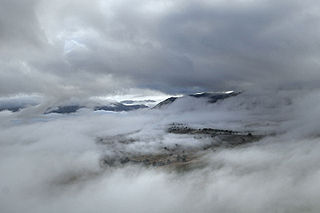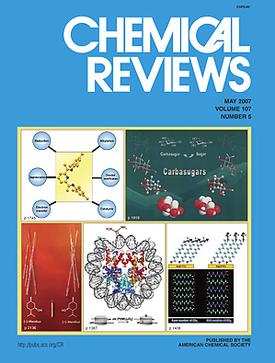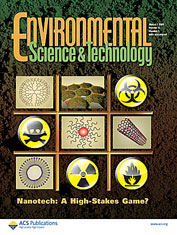
The greenhouse effect occurs when greenhouse gases in a planet's atmosphere trap some of the heat radiated from the planet's surface. A planet is warmed by absorbing light from its host star and cooled by radiating energy into space. The warm surface of a planet emits infrared thermal radiation. Greenhouse gases absorb some of that radiation, reducing the amount of energy that escapes into space. This reduction in planetary cooling raises the planet's average surface temperature. Adding greenhouse gases to the atmosphere increases the warming effect.

An aerosol is a suspension of fine solid particles or liquid droplets in air or another gas. Aerosols can be natural or anthropogenic. Examples of natural aerosols are fog or mist, dust, forest exudates, and geyser steam. Examples of anthropogenic aerosols include particulate air pollutants, mist from the discharge at hydroelectric dams, irrigation mist, perfume from atomizers, smoke, dust, steam from a kettle, sprayed pesticides, and medical treatments for respiratory illnesses. When a person inhales the contents of a vape pen or e-cigarette, they are inhaling an anthropogenic aerosol.

Global cooling was a conjecture, especially during the 1970s, of imminent cooling of the Earth culminating in a period of extensive glaciation, due to the cooling effects of aerosols or orbital forcing. Some press reports in the 1970s speculated about continued cooling; these did not accurately reflect the scientific literature of the time, which was generally more concerned with warming from an enhanced greenhouse effect.

The first systematic measurements of global direct irradiance at the Earth's surface began in the 1950s. A decline in irradiance was soon observed, and it was given the name of global dimming. It continued from 1950s until 1980s, with an observed reduction of 4–5% per decade, even though solar activity did not vary more than the usual at the time. Global dimming has instead been attributed to an increase in atmospheric particulate matter, predominantly sulfate aerosols, as the result of rapidly growing air pollution due to post-war industrialization. After 1980s, global dimming started to reverse, alongside reductions in particulate emissions, in what has been described as global brightening, although this reversal is only considered "partial" for now. The reversal has also been globally uneven, as the dimming trend continued during the 1990s over some mostly developing countries like India, Zimbabwe, Chile and Venezuela. Over China, the dimming trend continued at a slower rate after 1990, and did not begin to reverse until around 2005.
The impact factor (IF) or journal impact factor (JIF) of an academic journal is a scientometric index calculated by Clarivate that reflects the yearly mean number of citations of articles published in the last two years in a given journal, as indexed by Clarivate's Web of Science.

The IPCC Third Assessment Report (TAR), Climate Change 2001, is an assessment of available scientific and socio-economic information on climate change by the IPCC. Statements of the IPCC or information from the TAR were often used as a reference showing a scientific consensus on the subject of global warming. The Third Assessment Report (TAR) was completed in 2001 and consists of four reports, three of them from its Working Groups: Working Group I: The Scientific Basis; Working Group II: Impacts, Adaptation and Vulnerability; Working Group III: Mitigation; Synthesis Report. A number of the TAR's conclusions are given quantitative estimates of how probable it is that they are correct, e.g., greater than 66% probability of being correct. These are "Bayesian" probabilities, which are based on an expert assessment of all the available evidence.

Chemical Reviews is peer-reviewed scientific journal published twice per month by the American Chemical Society. It publishes review articles on all aspects of chemistry. It was established in 1924 by William Albert Noyes. As of 1 January 2015 the editor-in-chief is Sharon Hammes-Schiffer.
BioScience is a monthly peer-reviewed scientific journal that is published by Oxford University Press on behalf of the American Institute of Biological Sciences. It was established in 1964 and was preceded by the AIBS Bulletin (1951–1963).
The Journal of Palestine Studies (JPS) is a quarterly peer-reviewed academic journal established in 1971. It is published by Taylor and Francis on behalf of the Institute for Palestine Studies, having previously been published by the University of California Press. The editors-in-chief are Rashid Khalidi (Columbia University) and Sherene Seikaly (UC Santa Barbara). The journal covers Palestinian affairs and the Arab–Israeli conflict.
Pratim Biswas is currently the Dean of Engineering, University of Miami, since January 2021. He was the Lucy and Stanley Lopata Professor of Environmental Engineering Science, Asst. Vice Chancellor for International Programs, and Chair of the Department of Energy, Environmental and Chemical Engineering at Washington University in St. Louis. He is also Director of MAGEEP, the McDonnell Academy Global Energy and Environmental Partnership. He received his doctoral degree from the California Institute of Technology, Pasadena in 1985, and his bachelor's degree in Mechanical Engineering from the Indian Institute of Technology, Bombay in 1980. He was elected to the United States National Academy of Engineering in 2019 "for advancing the science of aerosol dynamics and particle removal technologies."
Journal Citation Reports (JCR) is an annual publication by Clarivate. It has been integrated with the Web of Science and is accessed from the Web of Science Core Collection. It provides information about academic journals in the natural and social sciences, including impact factors. The JCR was originally published as a part of the Science Citation Index. Currently, the JCR, as a distinct service, is based on citations compiled from the Science Citation Index Expanded and the Social Sciences Citation Index. As of the 2023 edition, journals from the Arts and Humanities Citation Index and the Emerging Sources Citation Index will also be included.

Environmental Science & Technology is a biweekly peer-reviewed scientific journal published since 1967 by the American Chemical Society. It covers research in environmental science and environmental technology, including environmental policy. Environmental Science & Technology has a sister journal, Environmental Science & Technology Letters, which publishes short communications.

David A. Edwards is an American biomedical engineer, and the founder of Sensory Cloud. He was the Gordon McKay Professor of the Practice of Biomedical Engineering at Harvard University.

Stratospheric aerosol injection is a proposed method of solar geoengineering to reduce global warming. This would introduce aerosols into the stratosphere to create a cooling effect via global dimming and increased albedo, which occurs naturally from volcanic eruptions. It appears that stratospheric aerosol injection, at a moderate intensity, could counter most changes to temperature and precipitation, take effect rapidly, have low direct implementation costs, and be reversible in its direct climatic effects. The Intergovernmental Panel on Climate Change concludes that it "is the most-researched [solar geoengineering] method, with high agreement that it could limit warming to below 1.5°C." However, like other solar geoengineering approaches, stratospheric aerosol injection would do so imperfectly and other effects are possible, particularly if used in a suboptimal manner.

Particulates – also known as atmospheric aerosol particles, atmospheric particulate matter, particulate matter (PM) or suspended particulate matter (SPM) – are microscopic particles of solid or liquid matter suspended in the air. The term aerosol commonly refers to the particulate/air mixture, as opposed to the particulate matter alone. Sources of particulate matter can be natural or anthropogenic. They have impacts on climate and precipitation that adversely affect human health, in ways additional to direct inhalation.
Frontiers Media SA is a publisher of peer-reviewed, open access, scientific journals currently active in science, technology, and medicine. It was founded in 2007 by Kamila and Henry Markram, and has since expanded to other academic fields. Frontiers is based in Lausanne, Switzerland, with other offices in London, Madrid, Seattle and Brussels. In 2022, Frontiers employed more than 1,400 people, across 14 countries. All Frontiers journals are published under a Creative Commons Attribution License.

Sachchida Nand Tripathi is an Indian scientist who works in the field of Atmospheric Sciences. He is a Professor in the Department of Civil Engineering at Indian Institute of Technology, Kanpur. He currently holds the Arjun Dev Joneja Faculty Chair in the department. Council for Scientific and Industrial Research Government of India awarded him with Shanti Swarup Bhatnagar Award for Science and Technology, the highest science award in India, for his outstanding contribution in the field of Earth, Atmosphere, Ocean and Planetary sciences in 2014. Prof. Tripathi is an elected Fellow of major Sciences and Engineering academies of the country: Indian National Science Academy, National Academy of Sciences, Indian National Academy of Engineering and also holds J. C. Bose Fellowship of Department of Science and Technology (India).
Sreedharan Krishnakumari Satheesh is an Indian meteorologist and a professor at the Centre for Atmospheric and Oceanic Sciences of the Indian Institute of Science (IISc). He holds the chair of the Divecha Centre for Climate Change, a centre under the umbrella of the IISc for researches on climate variability, climate change and their impact on the environment. He is known for his studies on atmospheric aerosols and is an elected fellow of all the three major Indian science academies viz. Indian Academy of Sciences Indian National Science Academy and the National Academy of Sciences, India as well as The World Academy of Sciences. The Council of Scientific and Industrial Research, the apex agency of the Government of India for scientific research, awarded him the Shanti Swarup Bhatnagar Prize for Science and Technology, one of the highest Indian science awards for his contributions to Earth, Atmosphere, Ocean and Planetary Sciences in 2009. He received the TWAS Prize of The World Academy of Sciences in 2011. In 2018, he received the Infosys Prize, one of the highest monetary awards in India that recognize excellence in science and research, for his work in the field of climate change.
S. Suresh Babu is an Indian atmospheric scientist and the head of the Aerosols and Radiative Forcing Section at the Space Physics Laboratory of Vikram Sarabhai Space Centre. Known for his studies on the Atmospheric aerosols, Babu is a recipient of the Young Scientist or Associate Award of all the three major Indian science academies namely, National Academy of Sciences, India, Indian Academy of Sciences and Indian National Science Academy. The Council of Scientific and Industrial Research, the apex agency of the Government of India for scientific research, awarded him the Shanti Swarup Bhatnagar Prize for Science and Technology, one of the highest Indian science awards, for his contributions to Earth, Atmosphere, Ocean and Planetary Sciences in 2017.
Joyce Penner is an atmospheric scientist known for her research on climate change, especially on the impact of aerosols and clouds.










